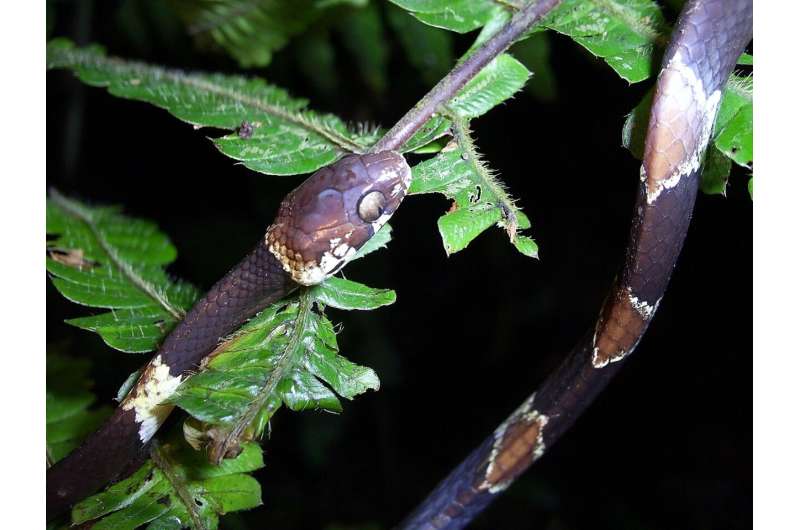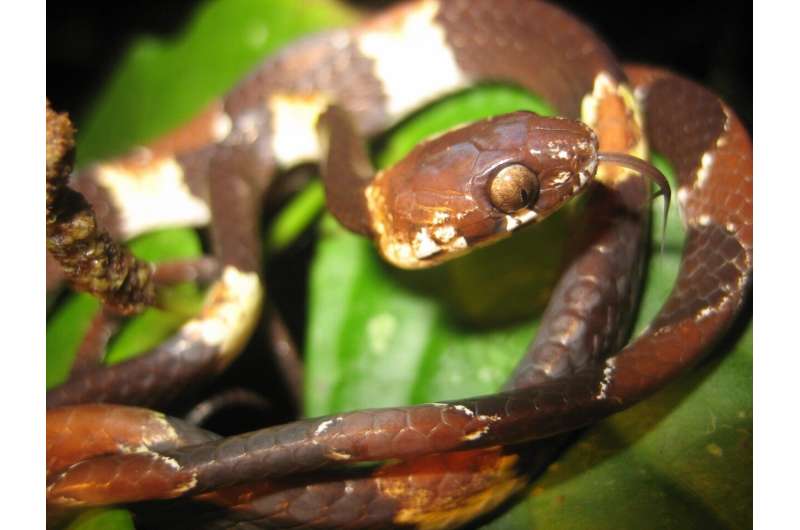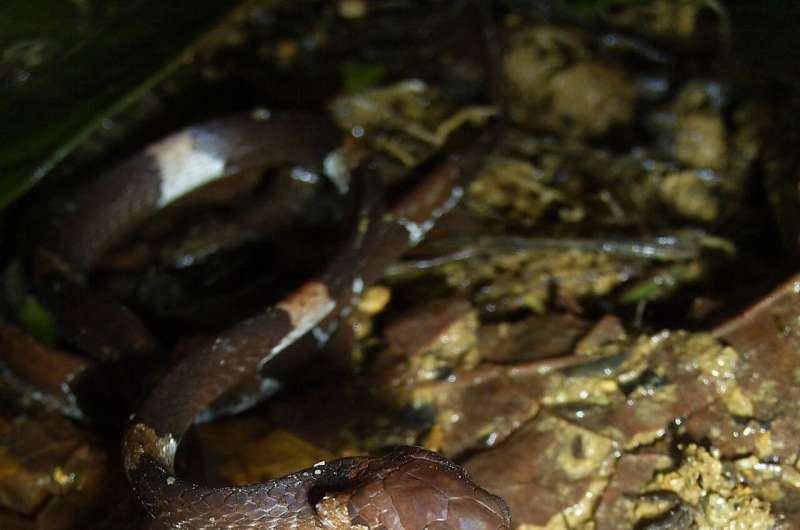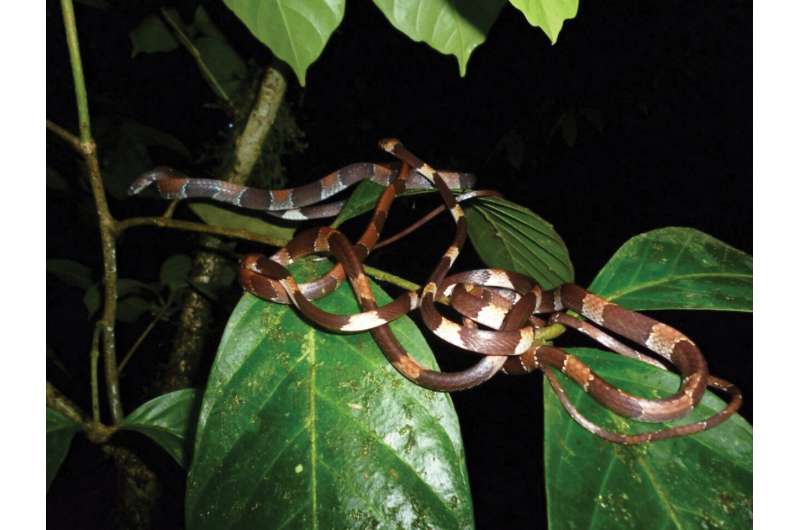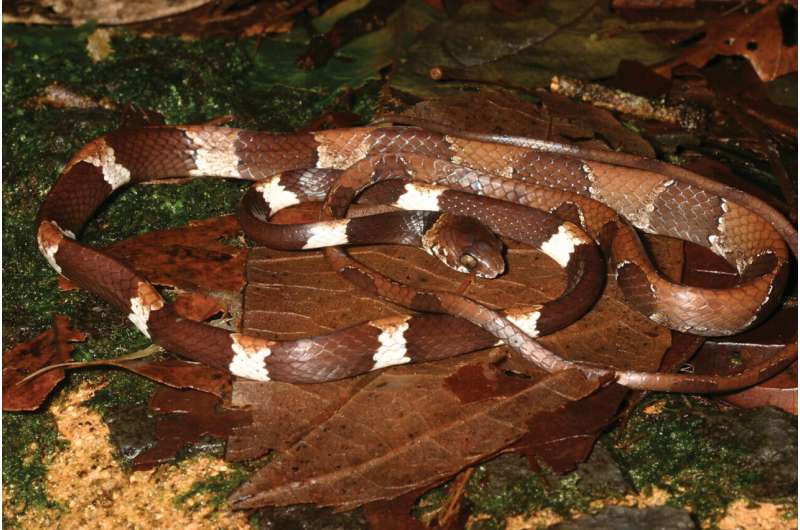The Hidden Snail-eating Snake, Dipsas aparatiritos. Credit: Dr. Julie M. Ray
A new species of snake was described from western Panama. First documented in 1977 by Dr. Charles Myers, a scientist studying amphibians and reptiles throughout Panama, it was only now that it got a scientific description.
The new snake has been given the name Dipsas aparatiritos. The genus Dipsas includes the snailsuckers, a unique group of snakes that feed on soft-bodied prey including snails extracted from their shells, slugs, and earthworms. The species epithet "aparatiritos" is Greek for unnoticed: a reference to the fact that the snake had remained hidden in plain sight for over forty years at a very well-studied field site.
Scientists Dr. Julie Ray, University of Nevada—Reno, Paola Sánchez-Martínez, Abel Batista, Daniel G. Mulcahy, Coleman M. Sheehy III, Eric N. Smith, R. Alexander Pyron and Alejandro Arteaga, have described the new species in a paper published in ZooKeys.
Dipsas aparatiritos has the characteristic bulbous head and brown-and-black patterning of many of the snakes in the genus. It looks very similar to its closest known relative, Dipsas temporalis, which is also found in Panama. It is now known that D. aparatiritos is endemic to, or known only from, the western and central parts of the country.
Panama has a rich diversity of snakes, with over 150 documented species in a country the size of Ireland or the U.S. state of South Carolina. Dr. Ray has documented over 55 species of snakes in Parque Nacional General de División Omar Torrijos Herrera where the newly described snake is best studied, and over 80 species in Coclé Province in Central Panama. She published a field guide, Snakes of Panama, in 2017.
The Hidden Snail-eating Snake, Dipsas aparatiritos. Credit: Dr. Julie M. Ray
Co-author of the species description Dr. Alex Pyron, The George Washington University, visited Parque Nacional General de División Omar Torrijos Herrera in June 2013 with Dr. Frank Burbrink, American Museum of Natural History. "That was my first trip to Central America," he says.
"We were able to see the after-effects of the amphibian declines. But I was struck by the diversity and abundance of snakes that were still present, including this species of snail-eater we have just described, the rare Geophis bellus [a small leaf litter snake known from just one specimen prior to this discovery] and an unusual Coralsnake."
Despite being a new species, Dipsas aparatiritos is relatively common in Parque Nacional General de División Omar Torrijos Herrera and has been studied for years before it was described. Dr. Ray has published a paper about the diet of snail-eating snakes, where it was found that earthworms from bromeliads compose a large portion of the diet of Dipsas aparatiritos. She also co-authored a paper on trophic cascades following amphibian declines, where it was found that Dipsas aparatiritos actually was increasing in numbers due to a diet independent of amphibians.
-
The Hidden Snail-eating Snake, Dipsas aparatiritos. Credit: Dr. Julie M. Ray
-
Four individuals of Dipsas aparatiritos intertwined on one plant at Parque Nacional General de División Omar Torrijos Herrera. Credit: Noah Carl
-
Live individual of Dipsas aparatiritos in Parque Nacional General de División Omar Torrijos Herrera photographed in the wild. Credit: Kevin Enge
Dipsas aparatiritos is already considered Near Threatened based on IUCN Red List standards. The snake is endemic to Panama and comes from a limited range in the cloud forests of mid-elevation, where at least 44% of the overall range has been deforested. In addition, as snakes are constantly persecuted by humans, almost all snake species are in danger of extinction in the near future. Efforts must be made to conserve these rare species, the researchers believe, especially as so many are just being described now.
"This work was a true collaboration of scientists from different countries each contributing their expertise to thoroughly understand this new species, morphologically and molecularly," said Dr. Ray.
"We are in an exciting time in science. Naturalists and scientists must continue to document the natural world; there are many species out there yet to be found and described. The usage of molecular techniques is exciting and facilitates the confirmation of so many new species."
More information: Julie M. Ray et al, A new species of Dipsas (Serpentes, Dipsadidae) from central Panama, ZooKeys (2023). DOI: 10.3897/zookeys.1145.96616
Luis C. Elizondo Lara et al, Range extension and natural history observations of a rare Panamanian snake, Geophis bellus Myers, 2003 (Colubridae: Dipsadinae), Check List (2015). DOI: 10.15560/11.4.1675
Julie M. Ray et al, Goo-Eaters: Diets of the Neotropical Snakes Dipsas and Sibon in Central Panama, Copeia (2012). DOI: 10.1643/CH-10-100
Elise F. Zipkin et al, Tropical snake diversity collapses after widespread amphibian loss, Science (2020). DOI: 10.1126/science.aay5733
Provided by Pensoft Publishers
